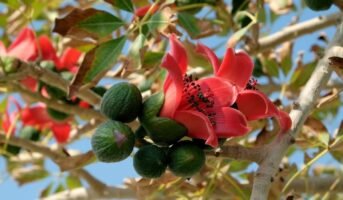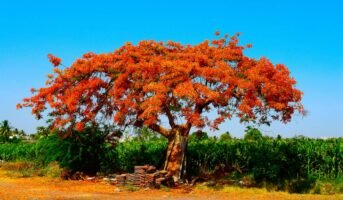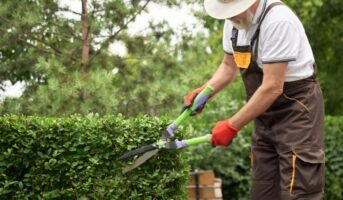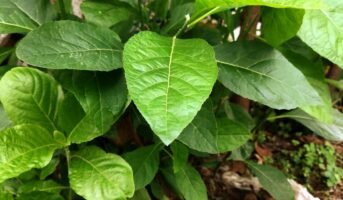The Ceiba pentandra is a tropical tree that is indigenous to Mexico, Central America, the Caribbean, northern South America, and West Africa. It belongs to the family Malvaceae and the order Malvales and is commonly known as the Kapok tree or silk cotton tree. In South and Southeast Asia, where it is grown, a somewhat smaller variant was introduced.
It may reach a height of 150 feet or more, dwarfing other jungle trees. The straight trunks may grow up to 9 feet in diameter and are cylindrical, smooth, and grey in appearance. The wood has a straight grain and ranges in hue from pinkish white to ashy brown. The branches extend out widely and develop in layers that are horizontal. The crown resembles an open umbrella.
The kapok tree has a large variety of living beings that grow and inhabit its branches. Its toxicity level is very low for animals, and the plant can easily be used to prepare herbal oral medications.
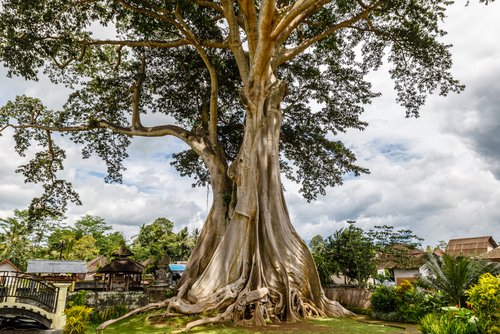
See also: All about Tabebuia rosea tree
Ceiba pentandra: Facts
| Botanical name: Ceiba pentandra |
| Type: Tropical tree |
| Flower: Yes |
| Also known as: Kapok tree |
| Height: 30-40m tall |
| Season: Throughout the year |
| Ideal temperature: 70 to 90 degrees Fahrenheit |
| Soil type: Well-drained |
| Soil pH: Slightly acidic to slightly alkaline |
| Basic requirements: Intermittent watering, indirect sunlight, home-made fertiliser |
| Ideal location for placement: Outdoors |
| Ideal season to grow: Entire year |
| Maintenance: High |

Source: Pinterest
Ceiba pentandra: Genus
Ceiba pentandra belongs to Ceiba genus that comprises 18 species. It is from the family Malvaceae and originated in the tropical and subtropical regions in America.
Ceiba pentandra: Native habitat
The native habitat of the plant is the tropical areas. Besides being found in Mexico, Central America and the Caribbean, and northern South America, the plant also grows in Africa.
Ceiba pentandra: How to grow?
- A kapok fruit is harvested when it is fully ripe. If it is dehiscent before it opens, the fruit changes colour from green to brown when it is ripe, and the surface sometimes wrinkles.
- In most cases, the fruits are harvested by knocking them off the tree before they ripen. A tree normally bears fruit between the ages of 3 and 8.
- The seeds are small and should be planted in early spring when they are 3-4 mm long.
- It takes about 4 weeks for the seeds to germinate, but the plant will take up to 8 months to mature.
Ceiba pentandra: How to maintain?
- After planting, water regularly so that the soil does not dry out too much.
- You should also provide some nutrients such as fertiliser and compost to help support the plant’s growth.
- In order to ensure that the nutrients in the soil for your Ceiba pentandra plant are replenished, add fertiliser or organic matter to the soil regularly.
Sun Tolerance
The plant can withstand full sunlight. Hence, it Is better to keep it in an outdoor area.
Mature Height
Kapok tree is known to grow tall and reach massive heights up to over 200 feet upon maturity.
Leaves
The plant leaves are six to seven inches in size and look shiny and green, with white or yellow variegation.
Cold Tolerance
The plant needs a minimum temperature of 15 degrees Celsius. Bring the plant inside the house and keep it protected during winter months.
Pruning
The plant needs proper pruning and maintenance.
Growth Rate
The Kapok tree is known to be a fast-growing tree. The plant can put at least 40 inches during its growing season for the initial 10 years.
Fruit
The fruits of Kapok trees typically begin to bear fruit when they are three to eight years old.
Ceiba pentandra: Uses
- The Asian rainforests, particularly those in Java (thus one of its popular names), the Philippines, Malaysia, and Hainan Island in China, as well as those in South America, are where the commercial tree is most extensively farmed.
- For bats and honey bees, the blooms provide a significant source of nectar and pollen. The majority of the night-blooming flowers’ pollinators are bats.
- The fibre is harvested by local tribes near the Amazon River and used to wrap blowgun projectiles.
- Decoction of the bark of Ceiba pentandra has also been used to treat type II diabetes and headaches and as an aphrodisiac.
- It is a component of several Ayahuasca drinks that contain hallucinogenic ingredients. The seeds can be used to crush vegetable oil.
- The oil is yellow in colour and resembles cottonseed oil in both flavour and aroma. When exposed to air, it rapidly goes rotten.
- Malaysia, Indonesia, and India all produce kapok oil. Its iodine value ranges from 85 to 100, making it a non-drying oil that does not considerably dry out when exposed to air. The oil has some promise for use in the manufacture of paint and as a biofuel.
- The fibres form a seal that enables the dart to be forced into the tube under pressure. The fibre is thin, very buoyant, tough, and water-resistant but also highly combustible.
- In the tropics, long stems one to two metres long are used for commercial purposes as half-ripe wood cuttings.
FAQs:
Where did Ceiba pentandra originate?
The Ceiba pentandra is indigenous to Mexico, Central America, the Caribbean, northern South America, and West Africa.
Does Ceiba pentandra have any medicinal uses?
Yes. Decoction of the bark of Ceiba pentandra has been used to treat type II diabetes and headaches and as an aphrodisiac.
Housing News Desk is the news desk of leading online real estate portal, Housing.com. Housing News Desk focuses on a variety of topics such as real estate laws, taxes, current news, property trends, home loans, rentals, décor, green homes, home improvement, etc. The main objective of the news desk, is to cover the real estate sector from the perspective of providing information that is useful to the end-user.
Facebook: https://www.facebook.com/housing.com/
Twitter: https://twitter.com/Housing
Email: [email protected]


